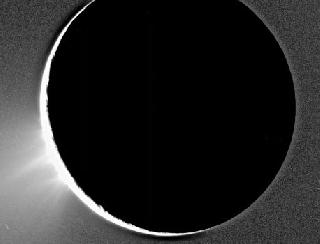
Recent Cassini images of Saturn's moon Enceladus. Photo: NASA.
LONDON (BNS): European Space Agency's Herschel Space Observatory has found a huge donut-shaped cloud, or torus, of water vapor created by Enceladus encircling Saturn.
According to JPL, the small, dynamic moon spews out dramatic plumes of water vapor and ice -- first seen by NASA's Cassini spacecraft in 2005.
The torus is more than 373,000 miles (600,000 kilometers) across and about 37,000 miles (60,000 kilometers) thick. It appears to be the source of water in Saturn's upper atmosphere.
The discovery of the torus around Saturn did not come as a complete surprise. NASA's Voyager and Hubble missions had given scientists hints of the existence of water-bearing clouds around Saturn.
In 1997, the European Space Agency's Infrared Space Observatory confirmed the presence of water in Saturn's upper atmosphere. NASA's Submillimeter Wave Astronomy Satellite also observed water emission from Saturn at far-infrared wavelengths in 1999.
Currently, most of the water in the torus is lost to space, some of the water molecules fall and freeze on Saturn's rings, while a small amount -- about 3 to 5 percent -- gets through the rings to Saturn's atmosphere. This is just enough to account for the water that has been observed there.
Herschel's measurements combined with the cloud models also provided new information about the rate at which water vapor is erupting out of the dark fractures, known as "tiger stripes," on Enceladus' southern polar region.
The Cassini-Huygens mission is a cooperative project of NASA, the European Space Agency and the Italian Space Agency.
 Next Article
Next Article












The Indian Air Force, in its flight trials evaluation report submitted before the Defence Ministry l..
view articleAn insight into the Medium Multi-Role Combat Aircraft competition...
view articleSky enthusiasts can now spot the International Space Station (ISS) commanded by Indian-American astr..
view article